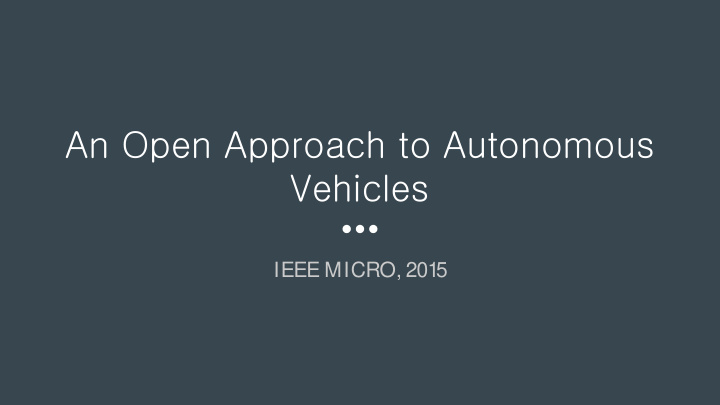



An Open Approach to Autonomous Vehicles IEEE MICRO, 201 5
Outline 1 . Introduction 2. Vehicles and sensors 3. Algorithms 4. Software 5. Datasets 6. Performance Requirements 2
Introduction Autonomous vehicles are becoming more prominent Problem: no systematic organization for research purposes Hardware Problems Commercial autonomous vehicles use a proprietary system interface No standard set of sensors Software Problems No open source libraries yet exist Algorithm design and implementation for 3
Vehicles and Sensors Introduce a set of modules, located in a plugin -in computer that can support Scene recognition Path planning Vehicle control Connected to Controller-Area-Network (CAN) bus networks Problem: proprietary nature of commercial vehicles does not support this Solution: ZMP Robocar Contains a control gateway through which commands can be sent to the car 4
5
Algorithms Autonomous driving component classification: Scene recognition Path planning Vehicle control 6
Algorithms - Scene Recognition Scene Recognition requires algorithms for: Localization Difficult in urban areas Use the Normal Distributions Transform (NDT) algorithm Performs scan matching over 3D point-cloud data and 3D Map data Can perform at the order of centimeters Chose NDT algorithms because their computation cost does not suffer from map size Object detection 7 Primary focus is moving objects, but also traffic lights and signs
NDT algorithm 8
DPM Algorithm 9
Algorithms - Scene Recognition (continued) Scene Recognition requires algorithms for: Object detection Sensor Fusion Uses data from the 3D Lidar sensor to detect objects by Euclidean clustering Goal: to determine distances to objects Distance is used to track objects classified by the image processing Object tracking Since object detection is run on every image frame, we can associate its results 10 Across multiple frames to predict trajectories
Algorithms - Path Planning Path Planning requires algorithms for: Mission planning Uses a rule-based mechanism to autonomously assign path trajectory e.g., lane change, passing, merging Once the path is assigned, the local motion planner is launched Rule: car stays in right lane until either: Passing another car Turning at an intersection 11 Motion planning: corresponds to driving behavior
A* Algorithm 12
Algorithms - Vehicle Control Autonomous vehicle follows path generated by motion planner Use Pure Pursuit algorithm for the path-following problem Break down path into several waypoints Every cycle, search for the closest waypoint in the direction you’re heading Set the velocity and angle of the next motion Update waypoint accordingly until goal is finally reached 13
Pure Pursuit Algorithm 14
Software stack Open source, publicly available framework: Autoware Vehicle completely operated by Autoware Components: Robot Operating System Point-Cloud Library OpenCV CUDA Android 15 F k
Software Stack Robot Operating System (ROS) Component based middleware framework for robot applications Abstracted by Nodes: represent individual component modules C++ programs Can launch several threads implicitly Topics: 16 contain input/output data between nodes
ROS Simplified example: 17
Software Stack Point -Cloud Library (PCL) Developed to manage point-cloud data Used by Autoware for localization and mapping Localization and mapping error of 10 to 20 cm Implements Euclidean clustering for object detection OpenCV Computer vision library for image processing Supports DPM algorithm for object detection 18 Provides API library functions for converting and loading images
Software Stack CUDA Framework for computing on GPUs Problem: autonomous driving algorithms are computing intensive CUDA improves execution speeds which is essential for real-time performance Android Used for the human-driver interface UI displays on a tablet in the car openFrameworks 19 P id di l t i li th t t f th
Datasets Problem: a 3D map is needed to localize the vehicle Autoware generates a 3D map This process is very time intensive Autoware is able to use 3D maps generated by itself and from third parties Allows for wide use in industry and academia Simulation requires datasets ROS provides simulation framework called ROSBAG Used to test functions of autonomous vehicles 20 P id h h f t ti t f t
ROSBAG Simulation 21
Performance requirements Numerous time constraints in autonomous driving Two problems: A* algorithm uses the most time, requiring several seconds or more However, only used for mission planning, runs only when path changes Real-time tasks (e.g., object detection and localization) DPM algorithm spends more than 1000 ms NDT take several ms These times must be reduced to operate in a real-time environment 22 U i th l t ith I t l i7 d N idi GTX980M GPU
Conclusion The ZMP car, Autoware platform, Robot Operating System and other introduced hardware and software comprise the first open source platform for autonomous driving vehicles Though there are currently latency problems, solutions have been proposed A designated onboard computer to handle multiple tasks, in real time is essential 23
Questions/Discussion How big of a concern is performance really? How could the authors solution be implemented? What other algorithms could be used to improve performance What real time problems would you anticipate in automated cars? What design changes could improve the car? What features would you add? (e.g., sensors, more cupholders, etc.) Was the Prius a mistake when they could have chosen a Lamborghini? 24
Recommend
More recommend